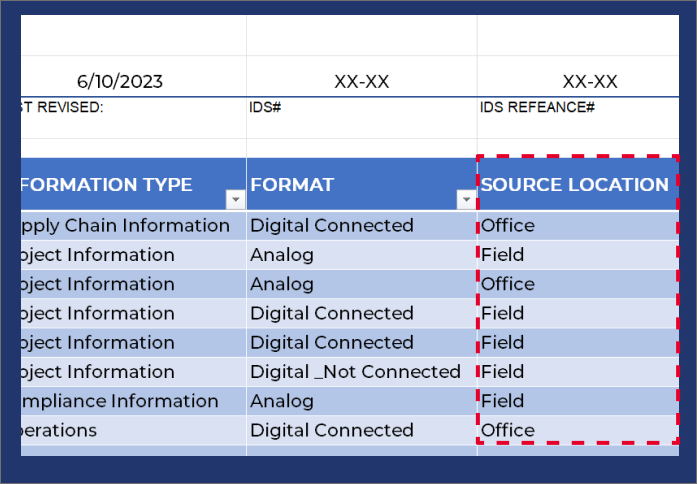Usage
General
This field has a drop down for the parameters listed below. These represent commonly used parameter labels for data discovery but can be added to on the List Reference tab of the IDS.
Usage

In this field we capture a brief description of the general usage of the data. This section can also be thought of as the jobs to be done by the data itself. Ask yourself the following question: Of the seven categories below what are we primarily using this data for?
This is important in understanding who is using this data and how important the data is to various aspects of your company and its processes. This is also a good way to check and see how data intensive different aspects of your business are or whether some aspects of your business are being neglected.
Best Practices
- Day-to-day Operations- This involves data about production rates, equipment usage, material consumption, work orders, and quality control results. It can also include data about daily tasks, schedules, workflows, and process efficiencies. All this information helps in tracking daily productivity and identifying areas for improvement.
- Fiscal Management- This refers to all financial data used to manage the company's financial health. It includes revenue, costs, budgets, financial projections, and cash flow data. This information is crucial for financial planning, cost control, profitability analysis, and investment decisions.
- Workforce Management- This includes data about the company's employees, such as work hours, productivity levels, skill sets, training history, and payroll data. This information can help manage staffing levels, improve productivity, identify training needs, and ensure fair compensation.
- Customer Relationship Management- This involves data about the company's customers and their interactions with the company. It includes customer contact information, project history, feedback, and service requests. This data can be used to improve customer service, identify upselling or cross-selling opportunities, and to build long-term relationships with customers.
- Supply Chain Management- This refers to data about suppliers, inventory levels, and logistics. It can include supplier performance data, delivery times, order quantities, and stock levels. This information helps ensure timely and cost-effective procurement of materials, manage inventory levels, and streamline logistics.
- Project Planning and Execution- This includes data related to individual projects, such as project plans, timelines, budgets, and progress updates. It can also include data about project risks and issues. This data is used to plan projects effectively, track their progress, manage risks, and ensure successful project completion.
- Regulatory Compliance- This involves data related to legal and regulatory requirements, such as safety records, inspection results, and compliance documentation. This information is crucial to ensure the company is meeting all legal requirements, maintaining a safe working environment, and avoiding any potential legal penalties.
Understanding Good Stewardship
 In subsequent chapters we will talk about technology workforce. Think about this as your data workforce, each piece of data has a job to be done.
In subsequent chapters we will talk about technology workforce. Think about this as your data workforce, each piece of data has a job to be done.

